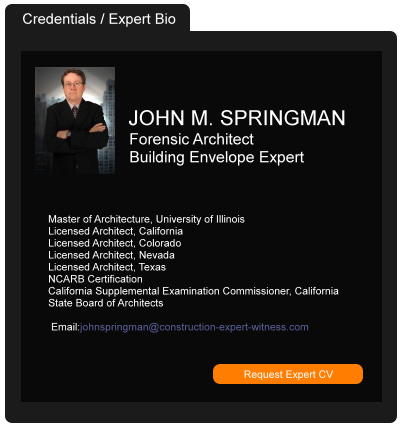Wreckage Removal Underway at Site of Collapsed Key Bridge in Baltimore, But Weather Slows Progress
April 15, 2024 —
Jim Parsons - Engineering News-RecordNote: The text of this article was updated 4/3/24 to reflect new information.
Weather and water conditions are hampering the piece-by-piece process of cutting and removing wreckage from the collapsed Francis Scott Key Bridge in Baltimore, while officials consider potentially utilizing progressive design-build for a replacement bridge. Officials remain uncertain as to how long the meticulous effort to clear the key shipping channel will take.
Reprinted courtesy of
Jim Parsons, Engineering News-Record
ENR may be contacted at enr@enr.com
Read the full story... Read the court decisionRead the full story...Reprinted courtesy of
PA Superior Court Provides Clarification on Definition of CGL “Occurrence” When Property Damage Is Caused by Faulty Building Conditions
September 30, 2019 —
Anthony L. Miscioscia & Konrad R. Krebs - White and Williams LLPThe standard for an “occurrence” under a commercial general liability (CGL) insurance policy has been addressed on several occasions by Pennsylvania courts when an insured has allegedly performed faulty workmanship on a construction project. Specifically, in Pennsylvania, a claim for damages arising from an insured’s performance of faulty workmanship pursuant to a construction contract, where the only damage is to property supplied by the insured or worked on by the insured, does not constitute an “occurrence” under the standard commercial general liability insurance policy definition. But what about the circumstance when the insured has failed to perform contractual duties where the claim is for property damage to property not supplied by the insured or unrelated to the service the insured contracted to provide? The Pennsylvania Superior Court recently addressed this question in Pennsylvania Manufacturers Indemnity Co. v. Pottstown Industrial Complex LP, No. 3489 EDA 2018, 2019 Pa. Super. 223, 2019 Pa. Super. LEXIS 729* (Pa. Super. 2019).
Pottstown Industrial Complex arose out of an underlying dispute between a landlord and a commercial tenant who had leased space to store its product inventory. The tenant alleged that the landlord was responsible under the lease for keeping the roof “in serviceable condition in repair.” Notwithstanding this responsibility, the tenant alleged that the landlord failed to properly maintain and repair the roof, resulting in leaks and flooding during four separate rainstorms, destroying over $700,000 in inventory. The tenant specifically alleged that the floods were caused by poor caulking of the roof, gaps and separations in the roofing membrane, undersized drain openings, and accumulated debris and clogged drains.
The insurer filed a declaratory judgment action, seeking a determination that there was no coverage under a commercial general liability policy issued to the landlord. Following a motion for judgment on the pleadings, the trial court entered an order in favor of the insurer, holding that allegations of inadequate roof repairs were claims for faulty workmanship and were not covered under Kvaerner Metals Division of Kvaerner U.S., Inc. v. Commercial Union Insurance Co., 908 A.2d 888 (Pa. 2006) and Millers Capital Insurance Co. v. Gambone Brothers Development Co., 941 A.2d 706 (Pa. Super. 2007).
Reprinted courtesy of
Anthony Miscioscia, White and Williams LLP and
Konrad Krebs, White and Williams LLP
Mr. Miscioscia may be contacted at misciosciaa@whiteandwilliams.com
Mr. Krebs may be contacted at krebsk@whiteandwilliams.com
Read the court decisionRead the full story...Reprinted courtesy of
Insurer’s Attempt to Shift Cost of Defense to Another Insurer Found Void as to Public Policy
June 09, 2016 —
Garret Murai – California Construction Law BlogWhile construction can sometimes be risky, construction litigation is almost always expensive. This volatile mix of risk and expense has made risk shifting, through indemnity and insurance, a primary goal and concern of project owners, contractors and suppliers alike. Construction insurers know this all too well and insurers, even between themselves, seek to shift risk.
As one primary insurer found, however, risk shifting provisions in their policies – specifically, one which sought to shift the cost of defense to another insurer – is not without its limitations.
Read the court decisionRead the full story...Reprinted courtesy of
Garret Murai, Wendel Rosen Black & Dean LLPMr. Murai may be contacted at
gmurai@wendel.com
New Jersey Federal Court Examines And Applies The “j.(5)” Ongoing Operations Exclusion
October 07, 2019 —
Anthony L. Miscioscia and Timothy A. Carroll - White and Williams LLPIn PJR Construction of N.J. v. Valley Forge Insurance Company, 2019 U.S. Dist. LEXIS 127973 (D.N.J. July 31, 2019) (PJR Construction), a New Jersey federal court held that the “j.(5)” “Ongoing Operations Exclusion” applied to bar coverage for property damage to property on which a construction company allegedly performed faulty work. The court’s opinion follows prior New Jersey state court precedent, including Ohio Casualty Insurance Company v. Island Pool & Spa, Inc., 12 A.3d 719 (N.J. Super. Ct. App. Div. 2011) (Island Pool), but also provides additional guidance on the elements which can make the Ongoing Operations Exclusion applicable to exclude coverage.
In PJR Construction, a commercial property owner engaged a construction company to build a 26,000 square foot swim club and related 3,000 square foot pavilion building in New Jersey. After about 75% of the work was completed, the property owner fired the construction company and denied it access to the property. The owner later sued the construction company in New Jersey state court alleging “shoddy workmanship” in, among other things, sealants, flashing, water resistant barriers, masonry and the handicap ramps. The construction company sought coverage from its CGL insurer, which denied coverage based on, among other things, the j.(5) Ongoing Operations Exclusion. After the denial of coverage, the company sued the insurer in New Jersey federal court seeking a declaration of coverage.
Reprinted courtesy of
Anthony L. Miscioscia, White and Williams LLP and
Timothy A. Carroll, White and Williams LLP
Mr. Miscioscia may be contacted at misciosciaa@whiteandwilliams.com
Mr. Carroll may be contacted at carrollt@whiteandwilliams.com
Read the court decisionRead the full story...Reprinted courtesy of
The Right to Repair Act Isn’t Out for the Count, Yet. Homebuilders Fight Back
October 02, 2015 —
Garret Murai – California Construction Law Blog“[I]t ain’t how hard you hit; it’s about how hard you can get hit, and keep moving forward. How much you can take, and keep moving forward. That’s how winning is done. . . .” – Sylvester Stalone as Rocky Balboa in Rocky Balboa.
Ding, ding.
The Little Case That Roared
Two years ago we wrote about a case that caused an uproar in the homebuilding industry – Liberty Mutual Insurance Company v. Brookfield Crystal Cove LLC, 219 Cal.App.4th 98 (2013) – in which the California Court of Appeals for the Fourth District held for the first time that the Right to Repair Act does not provide the exclusive remedy for construction defect claims involving “actual,” as opposed to “economic,” damages in new residential housing.
It was a blow to the homebuilding industry who back in 2002, following a wave of construction defect lawsuits involving new residential housing, lobbied the State Legislature for the Right to Repair Act which gave homebuilders an opportunity to repair defects before being sued in court.
Read the court decisionRead the full story...Reprinted courtesy of
Garret Murai, Wendel Rosen Black & Dean LLPMr. Murai may be contacted at
gmurai@wendel.com
More Musings From the Mediation Trenches
July 30, 2015 —
Christopher G. Hill – Construction Law MusingsAs those that read this construction blog on a regular basis know, I became a Virginia Supreme Court certified mediator a few years ago. I did so because I believe that mediation as a form of alternate dispute resolution is in most cases a much better alternative to resolve a construction dispute than litigation.
While I still act as counsel to construction companies participating in mediations (and have posted my thoughts on this topic on numerous occasions), working with the General District Courts of Virginia and acting as a mediator for private disputes has given me an interesting perspective on how the flexibility and process of mediation can resolve disputes in a way that formal court litigation or other forms of ADR may not.
After almost 4 years of working with the general district courts here in Virginia and working with private companies and individuals to resolve their disputes, I have come to the conclusion that often the real issue is not the money (though that is the big one) but some other intangible issue, whether an emotional one or some conflict of personality or even what may seem in hindsight to be a minor miscommunication. Because of this fact of life, and the life of a mediator, the ability to “vent” in the confidential setting of a mediation and in a way that no Court with rules of evidence could allow can go a long way toward a resolution of the dispute.
Read the court decisionRead the full story...Reprinted courtesy of
Christopher G. Hill, Law Office of Christopher G. Hill, PCMr. Hill may be contacted at
chrisghill@constructionlawva.com
Hurry Up and Wait! Cal/OSHA Hits Pause on Emergency Temporary Standards for COVID-19 Prevention
June 14, 2021 —
Michael Studenka & Jasmine Shams - Newmeyer DillionEmployers scrambling to prepare for the June 15th Reopening announced by Governor Newsom have spent the last week pouring over the revised Emergency Temporary Standards for COVID-19 Prevention (“Revised ETS”) approved by the Cal/OSHA Standards Board on June 3, 2021. After last night’s meeting of the Standards Board, however, it’s time to hit pause.
Last night, the Cal OSHA Standards Board held a specialty meeting to reconsider its Revised ETS in light of the latest guidance on face coverings issued by the California Department of Public Health (“CDPH”) on June 7, 2021. Following a presentation by the CDPH and extensive public comment, the Cal OSHA Standards Board voted unanimously to withdraw the Revised ETS and to take up the issue again at its next scheduled meeting on June 17, 2021. The net result in the interim is that California employers who intend to reopen on June 15 must initially comply with all of the requirements of the Cal/OSHA Standards Board Emergency Temporary Standards for COVID-19 Prevention as originally issued on November 20, 2020, including but not limited to, its social distancing, physical partitioning and mask wearing requirements.
Reprinted courtesy of
Michael J. Studenka, Newmeyer Dillion and
Jasmine Shams, Newmeyer Dillion
Mr. Studenka may be contacted at michael.studenka@ndlf.com
Ms. Shams may be contacted at jasmine.shams@ndlf.com
Read the court decisionRead the full story...Reprinted courtesy of
Downtown Sacramento Building Riddled with Defects
July 23, 2014 —
Beverley BevenFlorez-CDJ STAFFThe Board of Equalization tower in Sacramento, California has gone through $60 million in repairs to deal with issues such as bats, floods, leaky windows, mold, and glass panels that would “pop off the building with no warning and shatter on the sidewalk,” according to Insurance News. However, an additional $115 million in repairs are planned to deal with “crumbling core plumbing” and “concrete-and-glass exterior,” among other problems.
Now, “a Sacramento attorney filed a $50 million tort claim this month, a first step toward suing the tax-collecting department on behalf of employees who say their bosses downplayed the building's ailments and put workers' health at risk.”
"Even though my lawyers told me not to say this, I don't think it's safe," board Chairman Jerome Horton told Insurance News.
Read the court decisionRead the full story...Reprinted courtesy of


































































